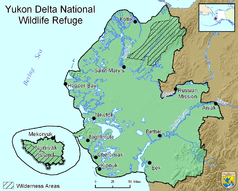Yukon Delta National Wildlife Refuge
| Yukon Delta National Wildlife Refuge | ||
|---|---|---|
| Autumn on the tundra of the Yukon Delta NWR | ||
|
|
||
| Location: | Alaska , United States | |
| Next city: | Bethel | |
| Surface: | 77,551 km² | |
| Founding: | 2nd December 1980 | |
The Yukon Delta National Wildlife Refuge is a 77,551 km² protected area of the National Wildlife Refuge System in the southwest of the US state Alaska in the Yukon-Kuskokwim Delta on the Bering Sea . The refuge also includes the two islands Nelson and Nunivak .
The deltas of the two rivers form a flat tundra crossed by rivers, lakes and ponds , which covers 70% of the protected area and reaches a maximum altitude of 30 m . In the hinterland of the wetland, the landscape changes into hills with trees and bushes and mountains with a height of up to 1200 m .
Wildlife

The Yukon Delta National Wildlife Refuge offers one of the largest nesting areas for waders in North America. The rivers provide spawning and retreat areas for 44 species of fish, including all five North American Pacific salmon species . Brown and black bears , moose , reindeer , wolves and musk ox live in the highlands . Marine mammals are found off the coast of the reserve . Whales pass the refuge on their migrations.
history
The area of today's Yukon Delta NWR was until about 10,000 years ago part of the Beringia land bridge , over which the first people probably immigrated from Asia to North America. Even today, the region is densely populated by Alaskan standards with 35 villages and around 25,000 inhabitants, many of them Yup'ik .
The first protection measures in the region took place in 1909 when US President Theodore Roosevelt designated a sanctuary for native birds. In 1929, Nunivak Island became a Bird and Wildlife Protected Area, to which the surrounding islands were added the following year. In 1937 the reserve was expanded again with the creation of the Hazen Bay Migratory Waterfowl Refuge by US President Franklin D. Roosevelt . In 1960, the Kuskokwim National Wildlife Range was created , which was expanded in 1961 and renamed Clarence Rhode National Wildlife Range and designated as a National Natural Landmark in 1968 .
On December 2, 1980, Jimmy Carter signed the Alaska National Interest Lands Conservation Act , which provided, among other things, that these already existing refuges and ranges were combined to form the Yukon Delta National Wildlife Refuge and expanded by around 54,000 km². Also in the course of the Conservation Act, the Andreafsky and Nunivak Wilderness Areas were created in the area of the refuges. The protected area is managed by the World Conservation Union in category IV ( biotope and species protection area ).
Web links
- US Fish & Wildlife Service: Yukon Delta National Wildlife Refuge (official site; English)
- Andreafsky Wilderness (English)
- Nunivak Wilderness (English)
Individual evidence
- ↑ National Natural Landmark: Clarence Rhode National Wildlife Range on nps.gov
- ↑ World Database on Protected Areas - Yukon Delta National Wildlife Refuge (English)



